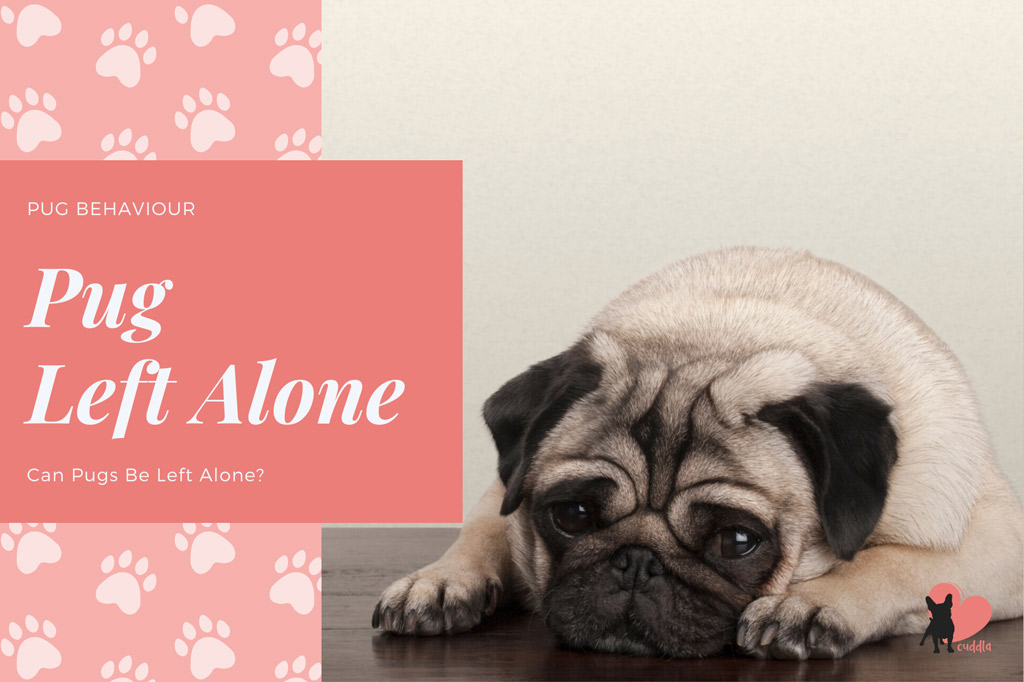
Dogs are social animals, and especially as house pets, they depend on us for a lot of their needs: companionship being a big one. So given the choice, your pooch will gladly have you around all day.
In reality, leaving the house without your dog is a part of everyday life. As a pug owner, you know how compassionate they are and how they love being around you, and you might question – can pugs be left alone?
House-trained adult pugs generally can be left alone for 4 to 6 hours a day. Pug puppies should not be left alone for more than 1 to 4 hours, depending on age. However, experts advise that the maximum amount that you should leave your Pug alone is 4 hours.
It’s important to understand the effect being alone has on your pug (since they can suffer from separation anxiety), and how age and background (foster, rescue, adopted) play a role in it.
Can Pugs Be Left Alone at Home?
Most dogs spend time at home alone on a daily basis. How long depends on the owners’ lifestyle and schedule.
But, is there a maximum time and rule on how long a dog can be left alone?
According to PSDA, the maximum amount that you should leave your dog alone is 4 hours. However, this can be difficult to live up to when you hold a regular 9-5 job away from home.
As a guideline, you can leave your pug alone between 4-6 hours a day (you will see the reasons why further down).
I generally like to aim for a maximum of 6 hours. In my experience with my own dogs and fostering dogs, I have found it depends on the dog’s age, personality, background and what he has grown used to.
Insider Tip: If you manage to keep a healthy balance between meeting your dog’s needs and leaving him alone, it can be that your dog handles the long stretch alone just fine.
Can Pug Puppies Be Left Alone?
Your pug’s age matters the most when deciding how long you can leave your pug alone.
Pug puppies can be left alone for 1 to 4 hours because they need to potty more frequently, and they cannot hold their bladder as adult pugs do.
On average, here’s a dog’s potty breaks frequency according to his age:
- 8-10 weeks old: Since pups at this age cannot hold their bladders, they can be left alone for less than 1 hour.
- 2-3months old: Generally they need to potty every 2 hours.
- 4 months old: They can hold their bladder for 4 hours, although it depends on your puppy’s development.
- 18 months old and over: As a general guideline, house-trained dogs can usually be alone without causing a potty accident for 6 hours. At night, adult dogs might be able to hold it for 8 hours because they’ve come to depend on us to go for a potty break in the morning.

How Long Can Pugs Be Left Alone?
In summary, here’s how long pugs can be left alone depending on age:
| PUG AGE | ALONE TIME |
|---|---|
| Adult pug (18 months) | 4 to 6 hours |
| Pug puppy | 1 to 4 hours |
| Senior pug | 4 to 6 hours |
But, how long is too long? Here are some FAQ’s to answer that:
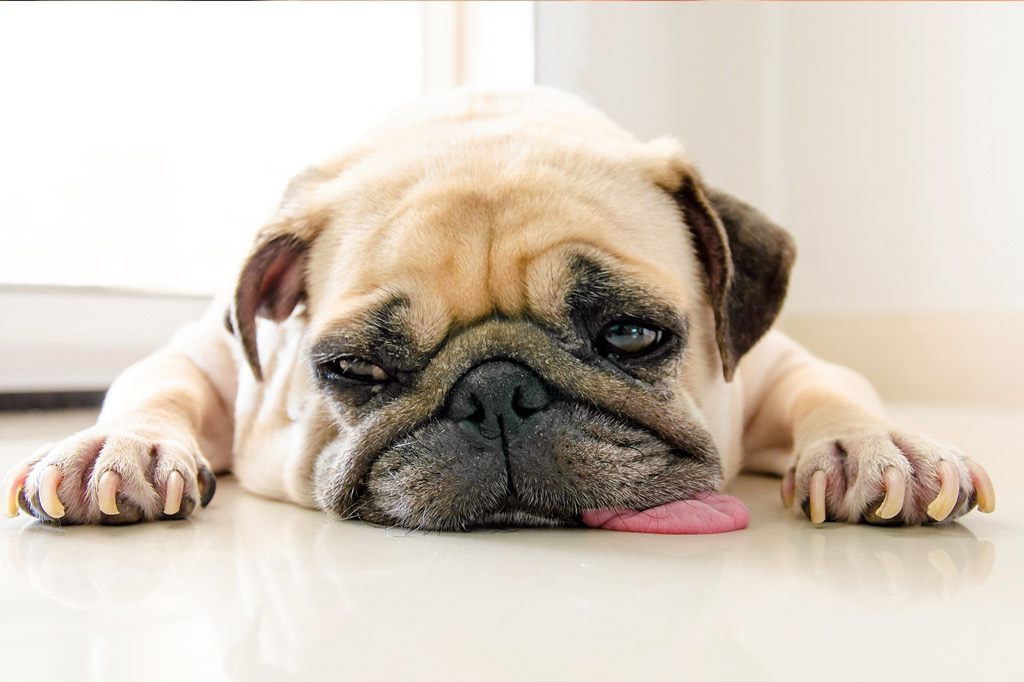
What Does Your Pug Do When Home Alone?
Knowing what your pooch is up to when you are away will help you to prepare him for the time alone.
The most likely scenarios are that your dog is going to:
- Sleep: On average, adult dogs sleep between 14-16 hours a day (including at night) and puppies can sleep up to 18 hours.
- Play: If you left a toy behind, your pooch will play for a bit, especially if the toy is interactive.
- Guard the house: This is a more likely behaviour for guard dogs such as Bullmastiffs, Chow Chows, Doberman Pinschers, German Shepherds and Mastiffs, for example. However, other dogs might be on the lookout to find out what’s going on.
- Eat: Some dogs will eat their meal from their bowl or a dispenser toy (a more entertaining method). However, others will hardly eat or not eat at all until you get back. This is something you should keep an eye on.
- Make noise: This highly depends on your dog’s breed and personality. Quiet breeds will refrain from making noises, but outspoken ones will bark at everything that moves (they have a much better sense of hearing than us). Also, dogs that suffer from separation anxiety will likely whine, cry, and even bark when you are away.
- Explore: If your dog is not left to remain in his safe space like a room or a crate, he will likely explore around the whole house! And this can be the cause of many hazards.
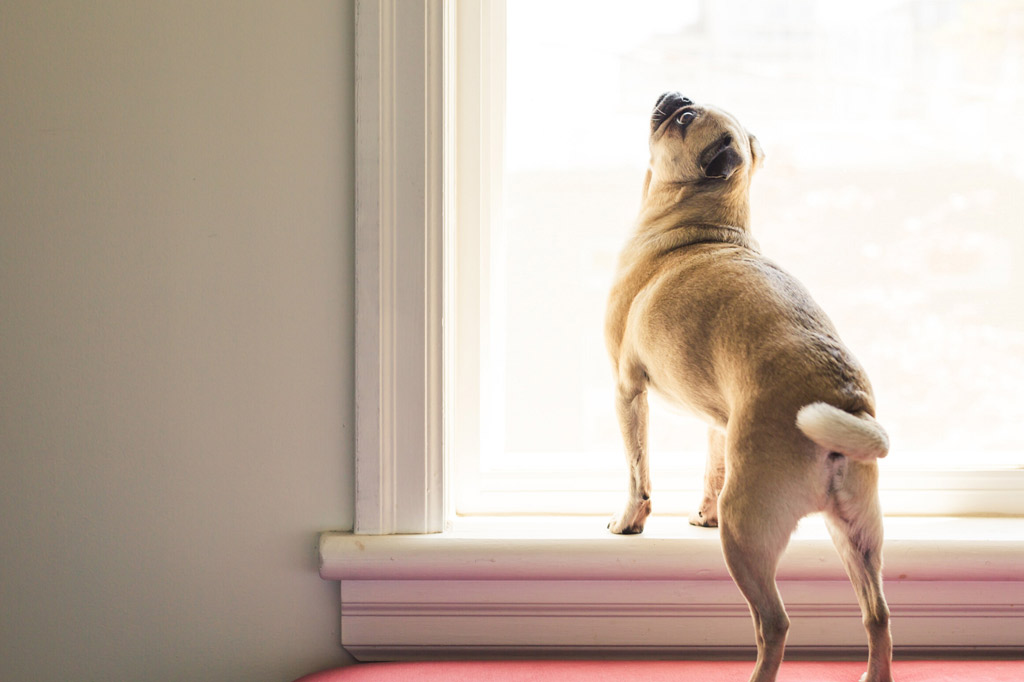
Why Does Leaving Your Pug Home Alone Has Risks?
Apart from age, your pug’s background and previous experiences will also determine how well he does being alone.
Pugs are companion dogs and they are prone to separation anxiety when left alone for too long.
This is why you shouldn’t count on pugs to be independent to such an extent that you can leave them for 8 hours a day while you are at work.
Your pug will, more likely than not, get lonely and anxious.
Pugs Get Lonely
Although so far there’s no data that shows dogs being aware of the length of time they were alone, this study does confirm that dogs are affected by the duration of time at home alone.
When we leave our pooch alone all day, it has an effect on them and it shows with a more intense greeting behaviour towards us, the owners.
Also, studies have shown dogs to display more physical activity and attentive behaviour when their owner returns, after 2 hours of separation.
Leaving your pug alone all day is definitely not advisable if you want a happy, well-adjusted family dog.
Pugs Suffer from Separation Anxiety
Separation anxiety in dogs is a behavioural disorder. Its main characteristic is a state of extreme anxiety or panic due to the dog being separated from their owner.
When this occurs, the most common visible signs that your pug has separation anxiety are:
- Elimination (i.e., urination and/or passage of bowel movements).
- Destruction (i.e., chewing).
- Excessive vocalization (i.e., barking, crying, whining).
According to AVMA, separation anxiety is one of the most common canine behaviour problems. 20% to 40% of dogs in the US are diagnosed with this disorder.
If you want to prepare your pooch to become confident when left alone, keep reading! You’ll be surprised by how the smallest things can make a huge difference for both of you. 🙂
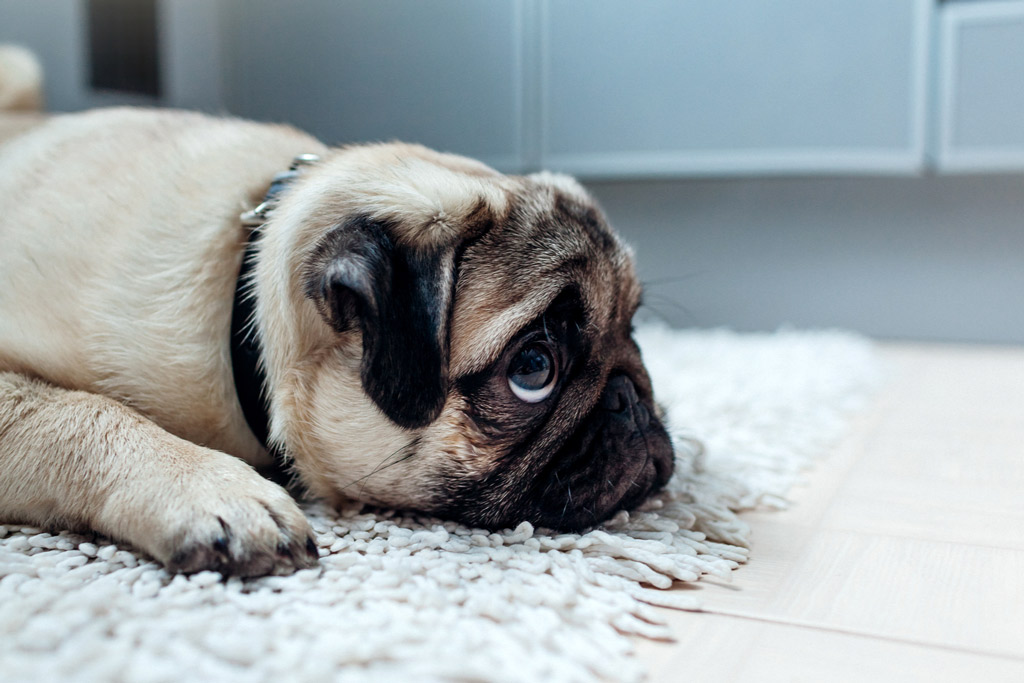
8 Tips to Make Leaving Your Pug Alone Easier
Leaving your pug alone is inevitable, but this doesn’t have to make both of you miserable!
For most dog owners, one of the main concerns is leaving their pooch home alone on a daily basis e.g. while at work.
Although it is hard to leave your furry friend behind, your pug can (and should be able to) handle short periods of alone time just fine.
Let’s see how you can convert this recurring situation into a safe, healthy and comfortable experience for your pooch.
#1 – Dog-Proof Your Home
This is one of the first things I highly recommend for everyone that brings a dog into their home.
It sounds basic but dogs can be a handful, and they can easily get themselves into trouble. Because of their curious nature, they can unintentionally jeopardize their safety and security.
As a rule of thumb, keep your pug away from anything that can be dangerous or that you simply don’t want to get damaged.
Here’s how to dog-proof your home:
| ❐ Use baby gates that limit access to rooms or stairs. |
| ❐ Get covers for electrical outlets. |
| ❐ Hide cables behind furniture. |
| ❐ Put safety locks on your kitchen and bathroom cabinets. |
| ❐ Keep all doors closed that are accessible within your dog’s safe zone. |
| ❐ Keep accessible windows closed too. |
| ❐ Keep breakables and tearables out of reach, from shoes to glass vases. |
| ❐ Store dangerous and toxic substances for your dog, including human food, medications, plants, and cleaning products. |
For a room-by-room checklist and poisonous substance list, check out our How to Make Your Home Dog-Friendly and Safe blog post.
#2 – Train Your Pug to Handle Being Home Alone
Training is the key to leaving your pug alone.
Getting your pug gradually ready to be alone will result in a confident dog that stays calm and comfortable by himself. He will learn that he’s safe and that you will always return to him.
To achieve this, train your dog from day 1 using crate training. You don’t necessarily have to lock your dog in a crate. But you have to teach him to be okay in a confined space that has enough room for him to move and to stay by himself for a while.
You can start with 5-minute sessions and build up to 20 minutes.
- At first stay at home, by your dog’s side.
- Then, just out of your dog’s sight.
- And gradually step out of the house.
Insider Tip: Every time your pug stays calm, tell him he’s a good boy and give him a small treat. Your pug will soon associate being calm and alone with a nice reward. You can even increase the reward and alone time accordingly.
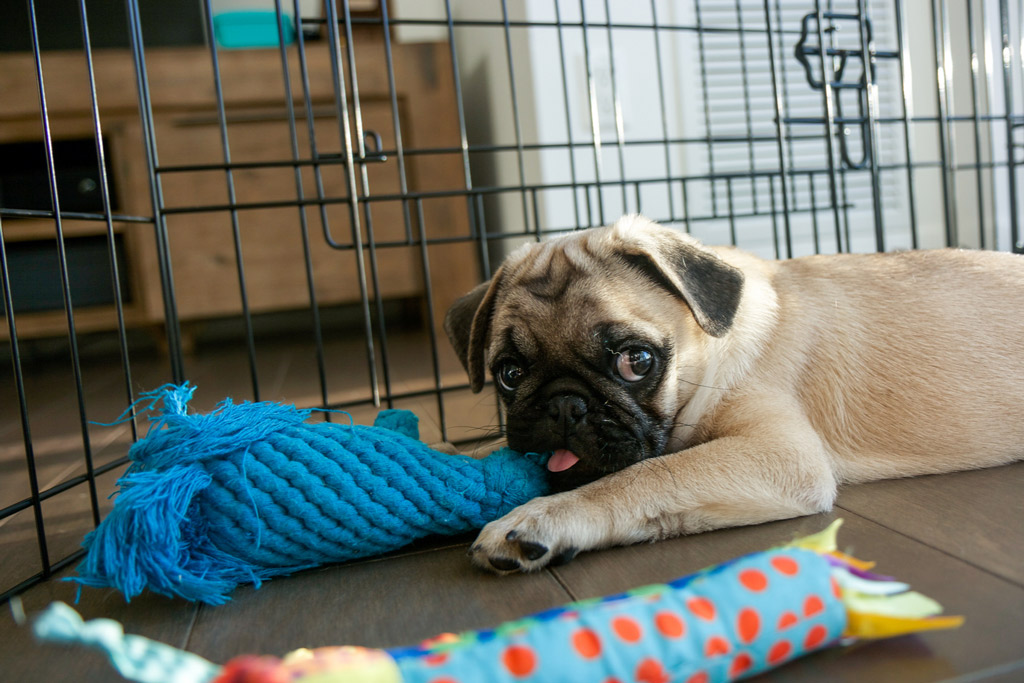
#3 – Keep Your Pug In His Safe Zone
Setting up a dog safe zone is one of the effective strategies for easing the process of leaving your pooch alone at home.
Basically, you are setting limits to potentially harmful situations and at the same time providing your pooch with the comfort he needs.
Your dog safe zone provides many benefits for both of you:
- You have crafted a dog-friendly area that is safe for your pug, i.e., hazard-free.
- It helps to train your dog to be away from you for a while, preventing separation anxiety.
- By the time you start leaving your pug alone, he already feels comfortable, relaxed and safe in his own space.
- Ultimately, your pooch goes into this area on his own, and also when you give him a verbal cue.
- Because of all of these, you worry less and feel more confident leaving your dog alone.
- It is also helpful for creating a sense of security when a dog sitter or walker is going to care for your pooch.
Think of your dog’s safe zone as an extension of his crate. When you leave the house, you can either limit the space where he is allowed to use a playpen or baby/pet gates that compliments your interior without compromising your dog’s security.
Either way, he should be restricted from wandering around the rest of the house to avoid dangerous situations or accidents (urinary, reaching for something valuable or harmful, etc.)
Finally, never leave your dog held up in his crate (door closed) for the whole day. He needs to be able to move around!
A crate should be a temporary location tool used for training (this is the time you close the crate door) and only used for short periods of time (for example, no more than 2 hours).
Insider Tip: As part of your dog’s safety when alone, don’t leave your pooch in the garden when you are not at home. This can lead to fatal situations like your dog escaping, or suffering from hypothermia, sunburn, or dehydration, for instance.
#4 – Tire Your Pug Before Leaving
Exercising your pooch before leaving is the best way to tire him.
If your furry friend has gone for a walk and spends some time sniffing, for example, he is more likely to sleep during the day. The result you’re looking for is that when your pug gets home, he goes to his bed to snooze.
By exercising your dog, you will not only tire him out but also prevent boredom.
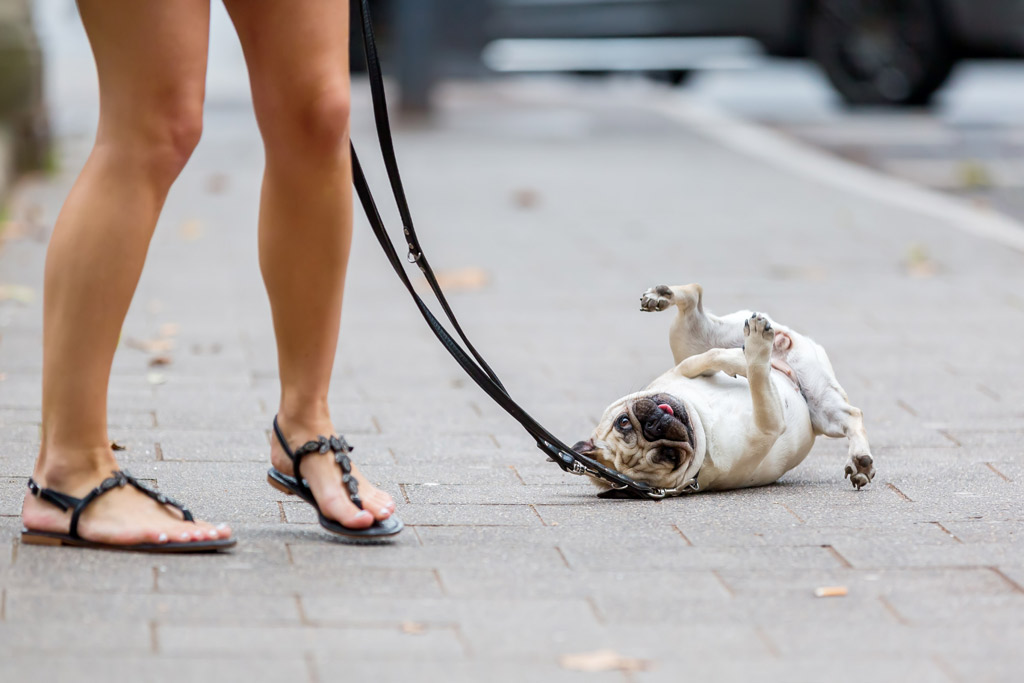
#5 – Don’t Overdo Your Goodbyes
It might be difficult for you not to overdo your goodbyes and refrain from using that baby voice to tell your pug how much you are going to miss him.
However, this behaviour is counterproductive as it can lead your dog to develop anxiety and stress. Instead, exit quietly after leaving your pug content with a toy in his safe zone.
Before leaving, make sure your pug has enough water in an accessible place and some food if necessary.
#6 – Provide Interactive Toys
According to PETA (People for the Ethical Treatment of Animals), an animal rights organization, dogs don’t want to be left alone due to:
- Loneliness.
- Lack of stimulation.
Lack of mental and physical stimulation can lead to various health and behavioural problems such as:
- Restlessness and boredom.
- Destructive chewing.
- Over-excitability and rough play.
- Depression.
- Frequent barking or whining.
- Obesity and lethargy.
- Escaping or digging.
- Irritability.
These interactive toys provide great entertainment and will keep your pug busy for a while:
- A seek-a-treat puzzle: A Snuffle Mat challenges your pug to use his nose and paws to find treats.
- A dog puzzle or “busy box” toy: It’s designed to challenge your dog. It contains compartments that hide food and require your pooch to figure out how to get to the food using his nose, mouth, and paws. Trixie puzzle toy, for example, has different training levels to increase the challenge!
- A treat ball toy: Bob-A-Lot gives your pooch something fun to chase around the room and surprise him with a tasty reward!
- Dispenser toys: Kongs are a classic option in this range. It comes in all sizes and for all ages. You can fill it with part of his meal. Also, you can freeze it for an extra challenge. It’s more entertaining for your pug to eat from a dispenser toy than from his food bowl.
- A chew toy: Rubber bones like Nylabone Flavored Bone or Kong Puppy Goodie Bone are also another source of stimulation. Chewing keeps your pug’s jaws strong and his teeth clean. Plus, it also combats boredom and can relieve mild anxiety or frustration.
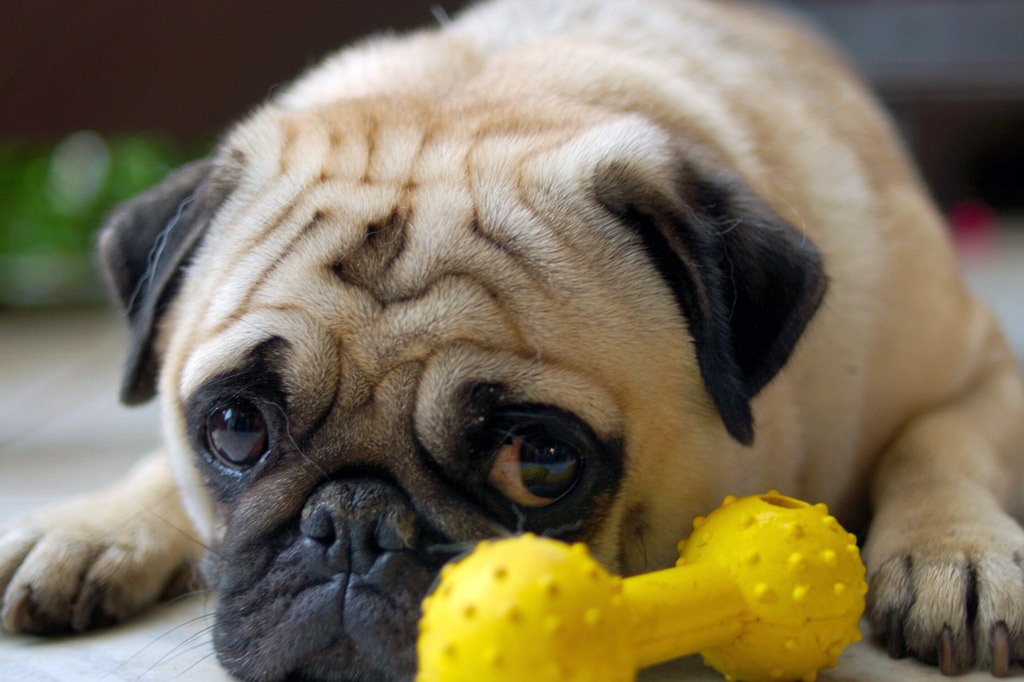
#7 – Keep an Eye On Your Pug
It’s great when you can actually use technology to close the distance when you’re away from home, and with a pet camera like Furbo (available on Amazon) you can monitor your pug.
This way you will be just two clicks away from communicating with him wherever you are.
This pet cam can also break up the day. You can talk to him and even offer some treats!
Most of these work over WiFi and via an app on your smartphone. Furbo Full HD Dog Cam with Treat Tossing Function has 2-way audio that also has a treat dispenser function. It holds 100 dry treats and you can toss your dog some by tapping the dispenser function on the app.
It also has night vision mode and can even send you push notifications if your pug starts barking!
#8 – Soothe Possible Fears and Anxiety
Anxiety is a major concern for many dog parents, especially when leaving their dogs alone.
Here are some solutions for soothing your pug’s uneasiness:
- Provide a plush toy designed to soothe dogs like Smart Pet Love’s Snuggle Puppy Toy.
- Leave the radio on and choose a non-stop classical music channel; it’s been known that dogs find it relaxing. Also, you can play some relaxing music designed for dogs that are found to soothe anxiety in our canine friends.
- Turn on the White Noise Sound Machine, it works wonders with dogs that suffer from anxiety. It also helps them sleep better (this is also applicable for humans!)
- Wraps like Thundershirt anxiety jacket help your dog relax when feeling fearful e.g. when there’s a thunderstorm.
- The lavender essential oil has also been proven to reduce the stress response in dogs. You can place two drops on your pug’s collar or bedding. Otherwise, you can use a diffuser around your house for an overall calming effect.
- As an alternative to lavender, Adaptil is a well-known diffuser to curb stress-related unwanted behaviours. The diffuser emits an odourless pheromone that provides a strong signal of comfort and security to dogs.
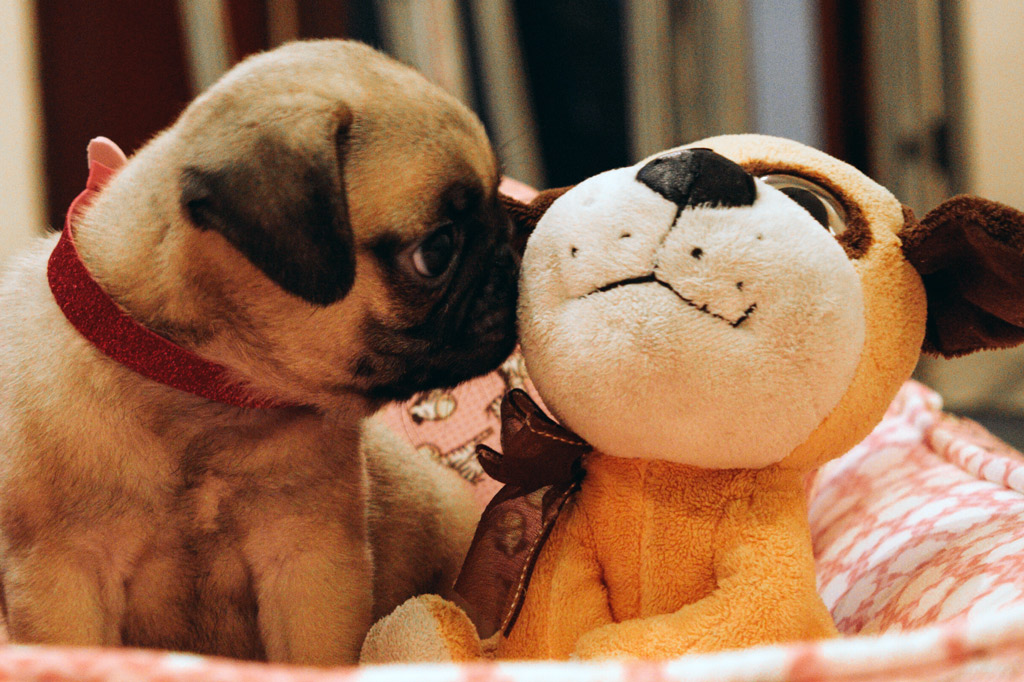
How to Reduce Your Pug’s Time Alone
There are a few ways to break up the day and the number of hours that your pug is alone in a single stretch.
Even a small break with a bit of human interaction can really help him to better cope for the second half of the day.
#1 – Take Your Dog to Work
Is your company pet-friendly by any chance? Then consider bringing your pug with you to work!
Of course, this depends on your job requirements and company policy, so find out if you can bring your dog to work with you.
Take the opportunity to read and encourage the benefits of having a dog and taking him to work, if you want to win some votes. 😉
#2 – Consider Working from Home
Alternatively, working from home might be an option. You could work from home a few days a week or full-time.
I work from home (which is a great advantage for dog fostering – something I feel strongly about) and use the opportunity to train my dogs on being OK with alone time and promoting independence, while still showing them I am around.
#3 – Hire a Dog Sitter or Dog Walker
You can hire a dog walker to ensure that your pooch gets a walk whilst home alone.
There are a lot of dog walking services around these days, depending on where you live, so it shouldn’t be too hard to find one – although make sure they are reputable i.e. hire a professional dog walker.
Check out my favourite dog care for my preferred choice!
#4 – Come Back Home For Lunch
If working from home and taking your pooch to work are not an option, could you go home for lunch?
If your workplace is close enough, consider returning home at lunchtime to walk your pug and give a potty break.
#5 – Engage a Family Member for a Visit
Ask someone you trust and who is available to spend some time with your pug. Your pooch will appreciate the company and the potty break.
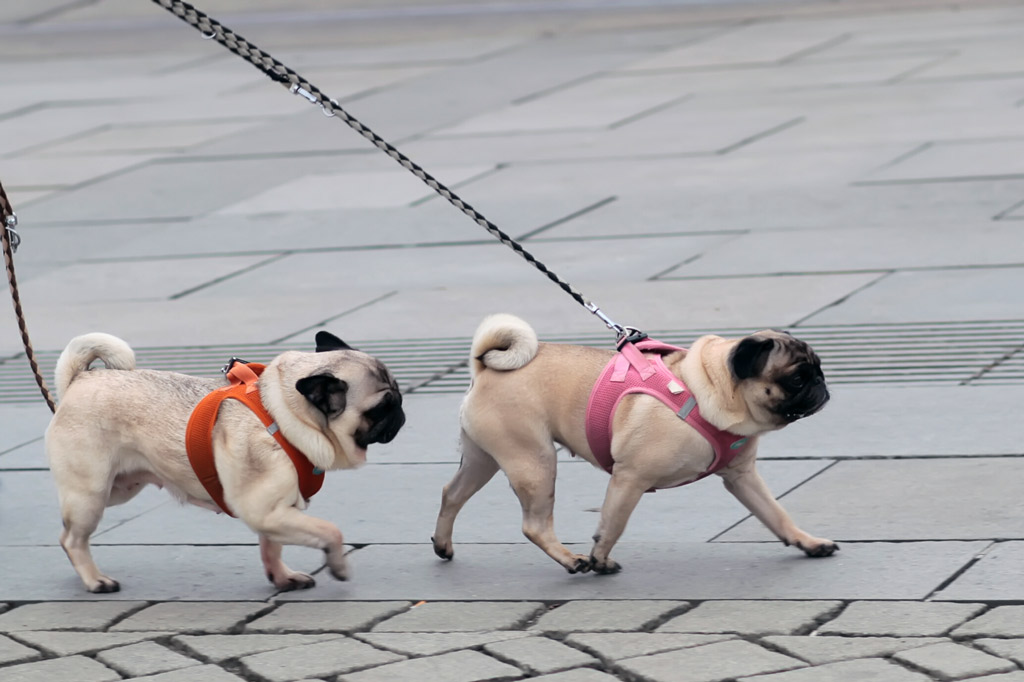

I like how you mentioned that Dogs are house pets and social animals. My sister mentioned to me last night that she is planning to buy a dog for my nephew for his birthday next week and asked if I have any idea what is the best option to do. Thanks to this informative article and I'll be sure to tell her that it will be much better if she consults a trusted puppy breeder as they can answer all her inquiries.
Thanks for sharing useful information with us. It really helped me a lot. The Pug is a real doggie who enjoys staying calm at home. He sleeps a lot and loves small naps, rocked by his soft snoring. In his basket, on the sofa, or nestled on his master's knees, everything suits him!